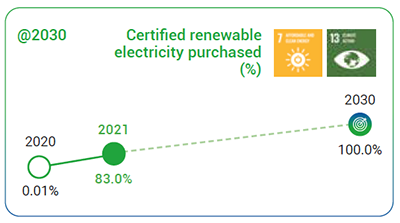The Group carefully monitors atmospheric emissions (measurements on chimneys, indirect calculations, number of leaks, etc.) in order to identify specific measures to reduce them and verify the results achieved on a regular basis.
The generation of electricity from renewable sources creates significant positive effects on the reduction of emissions and the predominant cogeneration framework (production of electricity and thermal energy that feeds the district heating networks) of the Group’s thermoelectric plants significantly contributes to containing specific greenhouse gas emissions.
All power generation plants are fuelled by renewable energy sources, waste or natural gas and adopt low-emission and pollutant-reducing combustion technologies (catalysts to reduce CO and NOX). Continuous emission monitoring systems make it possible to detect in real time the main pollutants and the improvement of the efficiency of the combustion process of cogeneration plants, larger thermal plants and waste-to-energy plants. The latter are also required, pursuant to the relevant Integrated Environmental Authorisations (IEA), to comply with stricter emission limits than those contained in national legislation.
Pursuant to the I.P.P.C. environmental legislation and relevant IEAs, it is mandatory for power plants with a capacity exceeding 50 MW to continually improve waste management services, by updating to the best available technology in order to continually reduce the pollution for the different environmental matrices, including atmospheric emissions.
The combustion of the biogas produced in landfills produces the maximum reduction of methane and other greenhouse gas emissions, although its conversion into CO2 has a potential greenhouse effect 28 times lower than methane.
In addition to monitoring and limiting emissions of power plants, Iren Group is increasingly contributing to reducing CO2 emissions through specific investments and projects, such as:
- heat storage systems that absorb the production capacity of plants during periods of low demand and reuse it to efficiently manage peak demand;
- district heating that uses heat produced in cogeneration, replacing traditional condominium boilers and reducing the natural gas consumption;
- sorted collection and material recovery from waste which allow to avoid emissions that the materials would have produced if sent for disposal and generate a positive impact on the environment, for example, through the reuse of plastics, including as a substitute for fossil fuels, and the production of compost and biomethane from organic waste;
- sustainable mobility and reduction of employee travel through smart working and agile ways of working.
la mobilità sostenibile e la riduzione degli spostamenti dei dipendenti tramite smart working e forme di lavoro agili.

1 The calculation considers as a benchmark the emissions of the national thermoelectric system equal to 452.268 kgCO2/MWh in 2021, 457.059 kgCO2/MWh in 2020 and 479.01 kgCO2/MWh in 2019 (Terna and PNA data). Data also include emission reductions from heat storage systems.
2 The calculation considers emission reductions from hydroelectric and photovoltaic plants, compared with the conventional thermoelectric mix.
3 CO2 avoided from waste takes into account: – production from biogenic sources: electricity produced from biogas (landfills and biodigesters), electricity and heat produced by WTE, assuming 51% of the total production of WTE as a renewable source (Source: GSE) and, in the event that there is also production of thermal energy, converting thermal energy into electrical energy according to specific factors (for PAI = 1/6.88, for TRM = 1/4.5, for Piacenza = 1/6) and applying the national reference parameter (see note 1); – sorted waste collection: correlation between the most significant tons of recycled waste (paper and cardboard, plastic, organic and green, wood, iron, glass) and the tons of CO2 equivalent saved (Source: Waste management options and climate change EC-AEA 2001); – material recovery: the emissions avoided by the primary materials recovered in Group plants that have been diverted from incineration (plastic, durable goods, other materials) or by the secondary raw material produced by their recovery (compost, bluair).
4 The calculation takes into account the amount of biogas from the wastewater treatment plants from which electricity was produced.
5 Internal Group initiatives were considered (e.g. energy efficiency of plants/processes, electric mobility).
In the Business Plan to 2030, the Group expects to avoid almost 2.3 million tons of CO2eq emissions thanks to sorted collection and recovery of materials and energy from waste.

| NOX and SOX emissions avoided1(t) | 2021 | 2020 | 2019 |
|---|---|---|---|
|
Nitrogen oxides (NOX) |
546 |
467 |
690 |
|
Sulphur oxides (SOX) |
229 |
271 |
435 |
1 The calculation considers emissions that, for the same amount of energy produced, would have been generated by domestic heating systems and the national electricity production network, subtracting the emissions effectively produced by the Group’s plants.